







 |
 |
 |
 |
 |
 |
 |
 |
Fantastic Four Hulk Spider-Man Thor Iron Man Dr Strange X-Men
We cannot rely on Stan Lee's memory of events:
"My memory is not the best,"
"I have the worst memory in the world,"
"obviously my memory is wrong." (Source)
"I even had a bad memory when I was young. I'd call him 'Bob Banner' instead of 'Bruce Banner,' etc. I hadda give out a heap of no-prizes!" (Stan Lee, on Twitter)
For example, for years Lee told the story of how he got his first job in comics by answering a newspaper ad. When confronted with evidence that actually his uncle got him the job, Lee admitted "I've been saying this [classified-ad] story for years, but apparently it isn't so. And I can't remember because I['ve] said it so long now that I believe it." (See Joe Simon's 1990 autobiography, "The Comic Book Makers").
Readers may also recall Stan's claim (in the famous 1966 newspaper interview) that he won the Herald Tribune competition three times. That claim has been thoroughly investigated and found to be false. (See "Stan Lee and the Rise and Fall of the American Comic Book" p.6).
So let's look at the origins of Marvel Comics, without relying on Lee's memory.
This is Stan Lee's memory of how the Fantastic Four came to be:
"Martin [Goodman, the publisher, and Stan's uncle by marriage] mentioned that he had noticed one of the titles published by National Comics seemed to be selling better than most. It was a book called The [sic] Justice League of America and it was composed of a team of superheroes . . . 'if the Justice League is selling', spoke he, 'why don't we put out a comic book that features a team of superheroes?'" Joan [Stan's wife] was commenting about the fact that after 20 years of producing comics I was still writing television material, advertising copy, and newspaper features in my spare time. She wondered why I didn't put as much effort and creativity into the comics as I seemed to be putting into my other freelance endeavors. . . . [her] little dissertation made me suddenly realize that it was time to start concentrating on what I was doing - to carve a real career for myself in the nowhere world of comic books."
"For just this once, I would do the type of story I myself would enjoy reading.... And the characters would be the kind of characters I could personally relate to: they'd be flesh and blood, they'd have their faults and foibles, they'd be fallible and feisty, and - most important of all - inside their colorful, costumed booties they'd still have feet of clay."
"After kicking it around with Martin and Jack for a while, I decided to call our quaint quartet The Fantastic Four. I wrote a detailed first synopsis for Jack to follow, and the rest is history." (Stan Lee [1974], "Origins of Marvel Comics")
Stan often retold that memory, with more details:
Is this memory reliable?
Readers with good memories will recall a similar claim by Stan, written back in 1947, called "Secrets behind the comics". In it, Stan claimed that Captain America was the result of Martin Goodman's foresight and genius. Even though Goodman simply bought a book that was already created by Joe Simon and Jack Kirby. Perhaps we should look again at Stan's claims:
Stan wanted to quit because he was bored?
Rather than Stan being a TV and newspaper writer who could choose other jobs, Stan was a desperate man. When the comics business slumped in the 1950s (largely due to Fredric Wertham) his uncle's comics lost their distributor and almost collapsed. Dick Ayers recalls: "Things started to get really bad in 1958. One day when I went in Stan looked at me and said, "Gee whiz, my uncle goes by and he doesn't even say hello to me." He meant Martin Goodman. And he proceeds to tell me, "You know, it's like a sinking ship and we're the rats, and we've got to get off." (source) Stan did not want to quit because he was bored, but because the ship was sinking.
"I was writing television material television material, advertising copy, and newspaper features"
This quote implies that Stan was a successful writer. But when you look closer it tells the opposite story. . In danger of losing his job, Stan tried creating a newspaper strip, called Willie Lumpkin. That was for "Publishers Syndicate", "a relatively small outfit" and "1960 was the only year the syndicate advertised it to potential buyers". (source) A few newspapers carried it for a while, but the last one stopped after 18 months. I can't find any other evidence of Stan Lee writing either "television material", "advertising copy", or "newspaper features". He probably sent off scripts, and no doubt did the odd job for his uncle's publications. But when in the 1970s he tried selling scripts he was generally unsuccessful, despite his fame from Marvel.
The golf game with Jack Liebowitz?
Comics historian Michael Uslan has researched this and it simply did not happen. Jack Liebowitz did not play golf. It was suggested that maybe Stan meant Irwin Donenfeld, but that didn't happen either. Could it be somebody else? Maybe, but why would you play golf with your direct competitor, and then give him your most valuable trade secrets, your sales figures? Goodman relied on copying trends, so he would have inside information from somewhere, but probably not golf.
Stan discussed it with Jack first
Stan wrote: "After kicking it around with Martin and Jack for a while, i decided to call our quaint quartet The Fantastic Four. I wrote a detailed first synopsis for Jack to follow, and the rest is history." This is the one part that agrees with all the evidence: Stan Lee discussed the possibilities with Jack Kirby "for a while" before deciding anything. This "Marvel method" is discussed in detail on the "who did what" page. Kicking it around for a while is the key. Then Stan wrote down his understanding of what they decided. Then Jack went away and created the story.
Stan disliked simple plots?
Stan said, "I really wanted to leave, because one edict that my publisher had was that the stories had to be geared towards young readers; or unintelligent older readers. We weren't supposed to use words of more than two syllables, and we had to have simple plots; no continuing stories, because he felt our readers weren't smart enough to remember from month to month where they had left off. It was really boring." But compare Stan's dialog with Jack's art. Or if you don't find that convincing, compare Stan's then current newspaper strip ("Willie Lumpkin") with Jack's much better selling "Sky Masters". Stan had complete freedom with Willie Lumpkin, yet provided one of the simplest. least demanding strips out there. Or compare Stan and Jack's work once they parted in 1970. Who had the simpler plots and easy to read dialog? Who had been editing Jack's work to make it simpler? Maybe Stan was right. Maybe he did want more complex work, but just not as complex as Jack was supplying. but the evidence always shows him choosing to simplify stuff.
Stan disliked secret identities?
Stan said, "Instead of the typical heroes that have secret identities and nobody knows who they are, I did The Fantastic Four; where everybody knew who they were." but Stan's dialog says otherwise. Issue 2 refers to "one of the Fantastic Four's many secret apartment hideouts". Perhaps this is due to that particular story? No, the cover to the next issue refers to their skyscraper "hide-out" and inside it is called "their secret headquarters". It quickly become obvious to Stan that a "secret skyscraper" was an oxymoron, especially when the art shows the team travelling there undisguised, in a flying car with bright searchlights, so Stan stopped referring to it as secret. But as late as issue 7, Stan's dialog said that Johnny Storm had a secret identity (in Strange Tales 101, published the same month). Again this contradicted the art and the idea was soon dropped.
Stan did it his way?
The core of the matter is that Stan decided to suddenly write great stories. Which is something he had never done before or since. He spent his life copying whatever kind of comic was already popular, so he was very good at writing quickly and creating passable stories. He was good at easy to read dialog and over-selling. But he had zero track record of creating anything successful, either before or since. Stan's list of original creations before 1961 includes... well, Willie Lumpkin. A gentle humour that didn't sell particularly well or for very long. And that's about it. Meanwhile Jack Kirby had created or co-created Captain America, the entire romance genre, original titles about dreams, war, space, westerns, pretty much anything you can imagine.
OK, fine. But Stan admitted that he had not really tried until then. Perhaps he suddenly got good? Then where is Stan's track record after he left Marvel? We have Stripperella, and... that's about the only memorable one. But Jack Kirby continued creating original characters that still sell today: Darkseid, OMAC, Mr Miracle, Kamandi, Eternals, and many many more. How likely is it that Stan Lee had a sudden and once-only flash of inspiration when he was around Jack Kirby (or Steve Ditko) and not at any other time?
The story synopsis
Decades later (in FF 358, 1991) a brief synopsis was published, outlining one third of
Fantastic Four issue 1. Stan remembered this as being a script, written
before Kirby was involved. However, all the evidence indicates that it was a summary of what was decided at the story meeting. It was therefore written after the discussion with Kirby.
Summary
In summary, Stan seems to be looking back at what Jack Kirby brought to the Fantastic Four, and remembering it wrongly. Now let's look at Jack Kirby's memory, and see which is supported by the documents:
Jack's version of events
According to Neal Kirby (Jack's son) Jack intended the FF to be a continuation of his Challengers of the Unknown series. This is from Neal's legal statement in the battles with Marvel:
Q What information, if any, do you have concerning the creation of The Fantastic Four?
A In discussions with my
father The Fantastic Four basically was a derivative of the, from what
he told me, basically he came up with the idea just as a derivative from
the Challengers of the Unknown that he had done several years earlier. (source)
This explains so much:
We do not have to rely on Kirby's recollection, the timeline of events
speaks for itself.
Pre-1958: Jack Kirby creates many hit comics
Kirby was far more famous than Stan Lee: Kirby's name appeared
on the covers of many comics, along with his frequent partner Joe Simon.
Simon and Kirby created Captain America, they created the entire
romance comic genre, and much more. Kirby's entire career was spent
creating new comic ideas.

Pre-1958: Stan Lee copies other people's ideas
Lee's career up to this point was in copying other people's ideas: if
a comic was a hit for somebody else, Lee produced an imitation. That
was just Lee's job. He worked for his uncle, Martin Goodman, and that
was Goodman's method. For details, see "The Secret History of Marvel
Comics" by Blake Bell and Michael Vassallo.
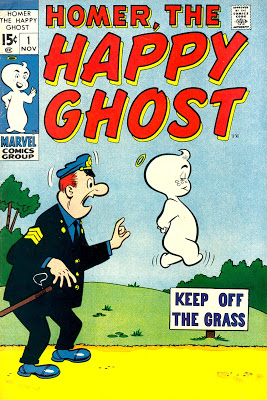
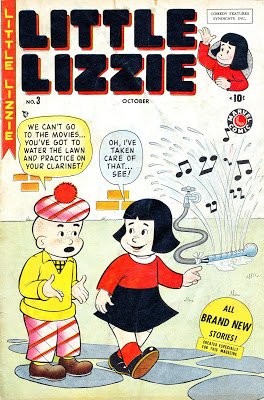
1958, April: Challengers
At this point, Kirby was still mostly working for DC. He created
"Challengers of the Unknown" for them, about a team of four daredevils
who explore the dangerous and unknown. Many people have noted the
similarities with the Fantastic Four: similar origin, similar
promotional pictures, similar costumes, similar stories, similar powers
(in one story), etc.

1958: Sky Masters
Kirby created "Sky Masters of the Space Force", a newspaper strip
about conquering space. It became successful, but Jack was helped by his
DC editor Jack Schiff, who wanted a cut of the money. Jack thought they
had only agreed to a one off payment.
1958, Dec: Timely
Bad feeling with Schiff at DC led to Kirby taking freelance work with Timely, who were then in dire trouble.
1959, June: fired from Challengers
Kirby was sacked from Challengers, as part of the dispute with Schiff.
Schiff gave the reason that "ideas from the Challengers story
conferences were finding their way into Kirby's Sky Masters work." (see
Ronin, "Tales To Astonish"). However, Jack's ideas for Challengers are
clearly similar to his work for Harvey in the previous months ("Alarming
Tales" issue 1-3), which were in turn derived from his horror comic
work, whiuch can be traced to his superhero work, and so on. So they
were Jack's ideas in the first place.
1959-60: Jack suggested superheroes
After losing Challengers, Jack was in urgent need of well paying work. But Timely (under Stan Lee) was doing
poorly and paying poorly. So Kirby came up with as many ideas as he
could. His Challengers work was full of
super powered beings, and he previously helped invent Captain America,
so he would naturally suggest
superheroes. But Timely relied on its bigger competitor, National (DC)
for distribution, Goodman did not want to annoy DC by competing
directly with DC superheroes.
1961, early: Sky Masters ended
Kirby stopped Sky Masters, due to the cost of the legal dispute.
1961, early: Mole Man story
It seems likely that as one of his many monster stories, Kirby
created the Mole Man story, featuring a team like the Challengers. This
was not published in its original form, but was later adapted for FF
issue 1.
1961, April: first man in space
Suddenly space iwas a hot topic, just at the time when Kirby had stopped his space comic and has ideas to spare.
1961, April: Justice League
The first sales figures for Justice League made superheroes seem viable again.
1961, April: Challengers continues
Goodman approved a comic that
mixed sci-fi and superheroes. It continued Kirby's "Challengers of the Unknown". It looked like a monster comic from the outside, so DC did
not see it as competition for the Justice League.
1961-1962: Challengers/Sky Masters FF
Kirby continued his Sky Masters theme of space travel (issues 1,2,6,7).
DC did not complain about the super powers. Sales were excellent. Goodman now felt superheroes were a safe bet.
The Hulk is a continuation of Kirby's other work at the time, creating Frankenstein-type monsters of all kinds (sometimes called "The Hulk")...

He also created Jekyl and Hyde characters. This page, from Kirby's story "Midnight Monsters" appeared just a few months before similar scenes in The Hulk:
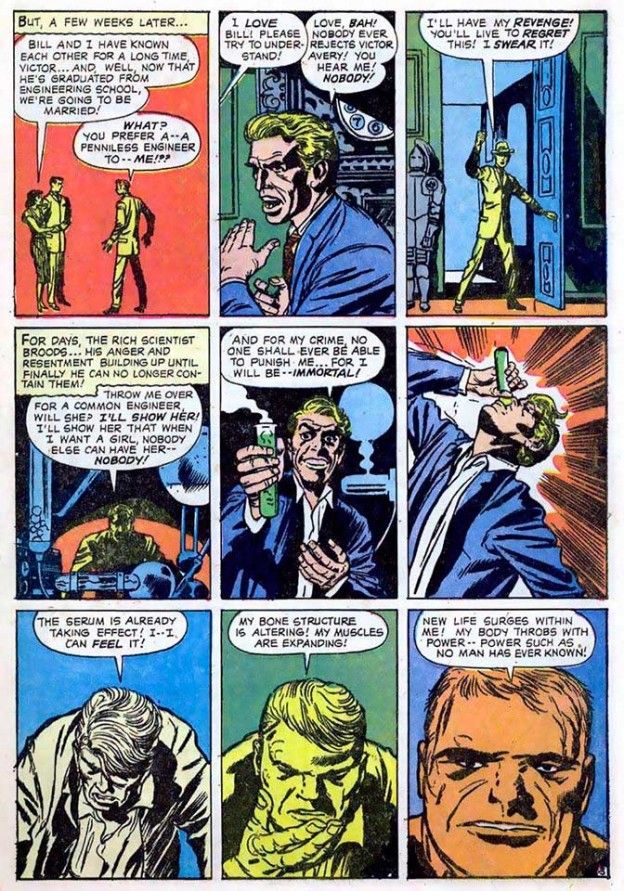
Of course, Stan Lee was involved in those two examples. But Lee's presence made no real difference: Kirby was creating the same kind of thing in the months before he rejoined Lee. His Challengers of the Unknown, for example, often featured super strong monsters:

And this sequence, from Kirby's solo work Sky masters, is almost identical to the origin of the later Hulk (thanks to Comic Book Historians for finding this):
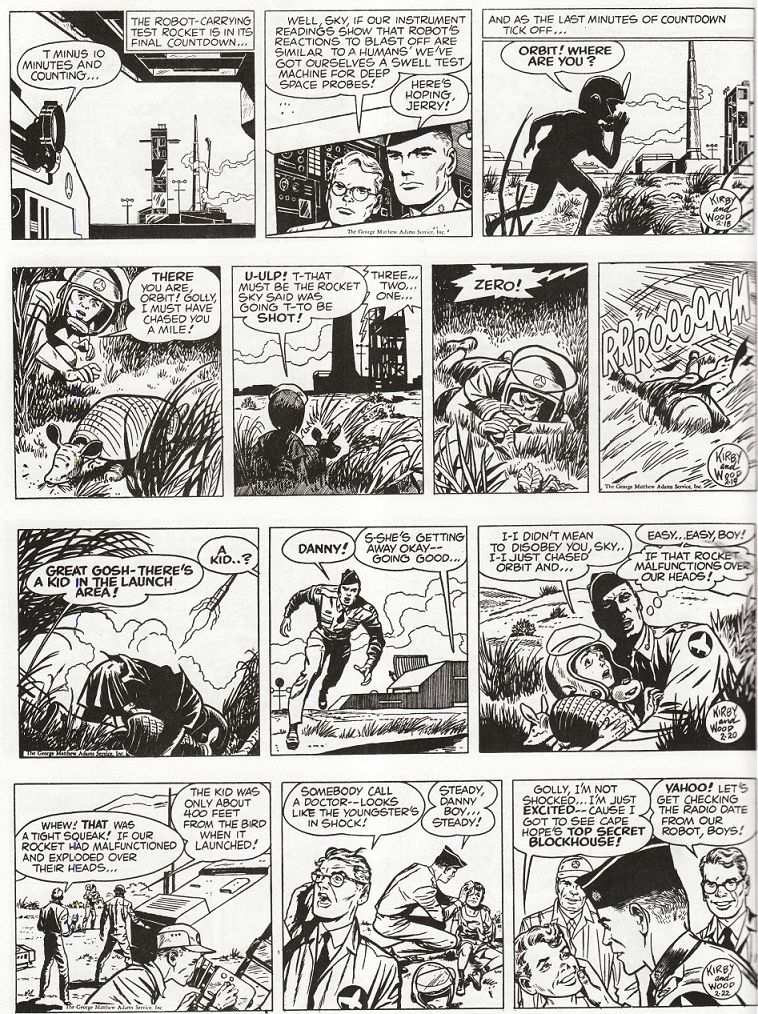
It's not just the Hulk himself: the secondary characters are often straight from Kirby's earlier work. Such as The Ringmaster and his Circus of Crime.


Here I will argue that Jack Kirby had the original idea for
Spider-Man, but Steve Ditko then handled the plot and art. Ditko made
Spider-Man a hit:
KIRBY: My initial concept was practically the same. But the credit for
developing Spider-Man goes to Steve Ditko; he wrote it and he drew it
and he refined it. Steve Ditko is a thorough professional. And he an
intellect. Personality wise, he's a bit withdrawn, but there are lots of
people like that. But Steve Ditko, despite the fact that he doesn't
discoľ although he may now; I haven't seen him for a long timeľ Steve
developed Spider-Man and made a salable item out of it." (source)


This raises some questions:
Jim
Shooter on the Kirby Spider-Man costume
"RE:
Kirby Spider-Man pages: I saw, and held in my hand, exactly one
such page. It was a page of design drawings. I remember that his
version of Spider-Man had a "Web-Gun" and wore trunks, I think,
like Captain America's. He was far bigger and bulkier than
Ditko's version. There were no similarities to Ditko's
Spider-Man costume. I think he had boots with flaps. There were
notes in he margin that described the character, again, nothing
like the Ditko version. I think there was something about him
being related to, or having some connection with a police
official, which was how he'd find out about trouble going
on. It was a long time ago, I can't swear to that last
item, but I can swear to the fact that it wasn't similar to the
Ditko version. I remember thinking, "This isn't at all like
Ditko's."
P.S. I must have
seen that page when I was in Sol's office and he was going
through the rejects stack looking for pages for me to try
inking. I don't think I ever got to look through those
pages again.
P.P.S. Years later,
1986, I had occasion to talk with Jack at the San Diego Con. He
insisted that he created Spider-Man. I told him that I'd spoken
to Steve Ditko, Sol, and other people who were there at the
time, including Stan, obviously, and that they all agreed that
Steve's version was the one that was used, though Jack did his
version first. I reported everything I'd seen and heard. We
talked about the costume -- the bib and belt combo, the stripes
down the arms, the mask, the symbols, a very Ditko-esque design.
Jack was having some problems with his memory by then, but he
thought about it for a minute, then said that maybe Steve should
get the credit. He'd be okay with that. A little later, he was
on stage and clearly had forgotten our conversation. He and Roz
did, however, come to Marvel's 25th Anniversary Party that
evening, which made me very happy. There's a story about that,
too, but it will wait for another time."
Stan Lee provided
So on balance, Kirby created Spider-Man, but Ditko made it a financial hit.
This is the third time Kirby created a Thor character (source). The fourth time if we include his "son of Thor" from Captain America 1:

In these examples note the distinctive chest plate and interest in
Loki. Each time the story centers on the hammer as the source of his
power.
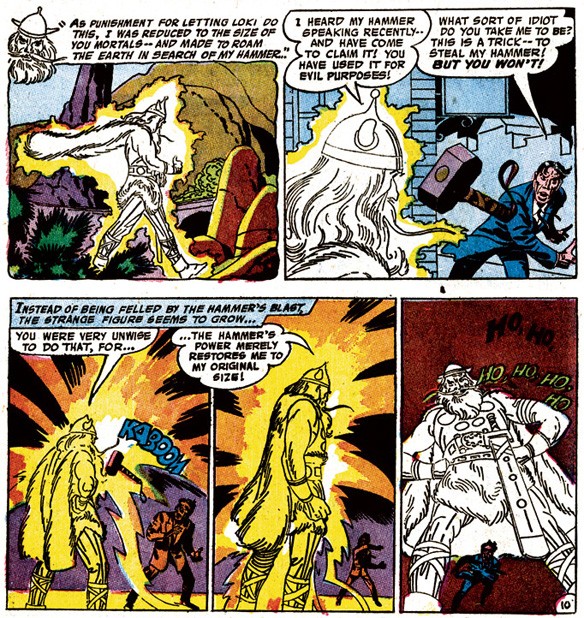
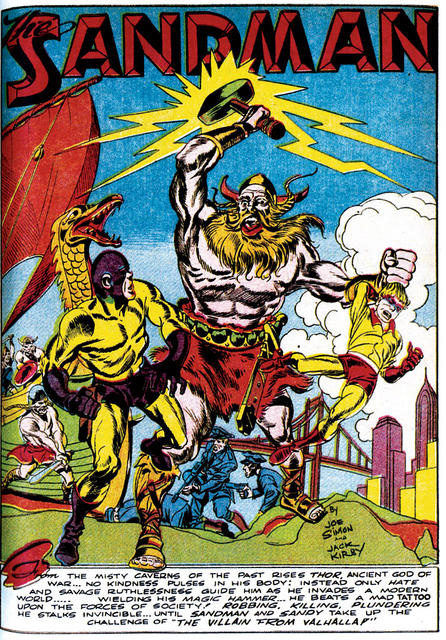
Here is Kirby's Thor splitting a tree with the hammer:

ANd here is the Marvel story:
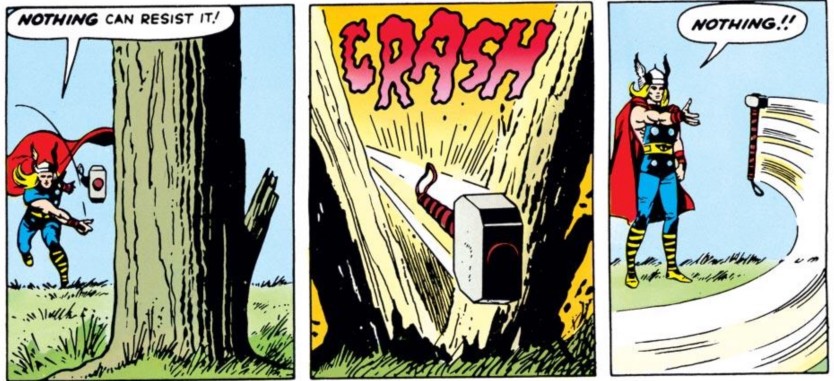
After the origin story it is clear that Kirby is still plotting whenever he draws. In the few issues where Kirby is not involved, the stories change radically and the quality nosedives. Instead of stories about Norse legends, we get silly characters like Cobra and Mr Hyde. But as soon as Kirby gets back the stories become epic again. For details, see my thread on the Classic Comics forum.
Iron Man is clearly based on an earlier Kirby character, Metallo: the wound in the heart, the metal chest plate, even the facial features:

The origin story - being forced to create a scientific miracle by a south east Asian warlord - is from this Kirby comic for DC:

Many people have commented on how Dr Strange is very similar to a Dr Droom (D-R-oom) from Amazing Adventures issue 1, in 1961. "Stan Lee has been quoted as saying Doctor Strange was kind of his second try at Doctor Droom." (source)

The story is credited to Stan Lee with pencils by Kirby and Ditko, so
it was probably Kirby's rough outlines and Ditko added the details. The
poses on page 1 for example are classic Kirby: indeed, the poses
throughout. Whereas some of the detail looks very Ditko-esque. That was
normal for first issues: if Kirby didn't have time to draw the whole
thing he would quickly rough it out for somebody else. According to the
Marvel Method, which was in use in 1961, Kirby should have plotted it as
well. We can see that he probably did from the art: it has been
changed, indicating that the original art had a different story. Why
would Stan Lee change his own story, and in such an odd way?
Evidence for changes
Look at that weird ending, where Dr Droom gets a Chinese face. That
isn't a Kirby or Ditko face, somebody else has drawn it on (or possible
Kirby or Ditko in a hurry). It's also a very weird ending: no decent
story teller would have planned that. And look at the large amount of
text crammed into the last pages: the artist did not expect that much
text. But if we remove the weird face and the dialog the pictures tell a
different story:

The old magician is on his death bed. The stranger hears something shocking. They embrace their hands, and some magical thing happens. Then the master is never seen again, but the stranger touches his face, and the servant treats him as the new master. Clearly the westerner has become the master. but that would mean he looked the same, and that might confuse readers. Plus he would be a very old hero, and Stan would not want that - kids can't relate to an ancient hero. So it looks like Stan got somebody to redraw the face. the face had to change - the art was clear - so Stan just had him turn Chinese instead, and wrote some extra dialog to explain it.
The flat face on page 1
Another point in favour of being redrawn is the strange face of the
hero at the start. It's flat, poorly drawn, so different from the three
dimensional faces elsewhere. Kirby and Ditko drew better faces than
that. And why all the crammed dialog saying that Droom was interested in
Tibet? If we take away the dialog and the art tells a simpler story.
The bald head, easy chair and pipe indicate that Droom was simply
retired. The other doctors were too busy to go on a wild goose chase,
but Droom was retired, so why not? And look closely at the hero's face
throughout the story (if you can find the original): several shots
suggest that he was either quite old or perhaps had a scar, or some
sickness. And note the similarity with the Dr Doom origin! Age or a scar
could make him a misfit, and more willing to go to Tibet. Indeed, the
story might not have been about a sick magician, but about Droom trying
to heal himself?
The name Droom
The name "Droom" means "a fantastic but vain hope (from fantasies induced by the opium pipe)". (Vocabulary.com)
Droom hoped to heal himself, but instead became the healer. However,
Stan Lee likes his male heroes to be idealised (and preferably saving a helpless female),
so a sick hero would trouble him. Of course, he later compromised and
let Dr Strange have injured hands - essentially the same plot, but
Steven Strange needed a handsome face! Who came up with that name? We do
not have minutes to the story conference, so cannot know for sure. but
throughout his career, from start to end, Kirby was coming up with wild
new ideas, indicating that he read widely. In contrast, Stan Lee's
career up to 1961 consisted of copying whatever comics sold well from
other publishers. When Stan Lee did not have Kirby around him he didn't
create any memorable characters. So in the absence of other evidence an
interesting name like Droom is more likely to be from Kirby than from
Lee.
So who wrote the Droom story?
We cannot be sure of course because we don't have the original pencils
or marginal notes. All we can say with reasonable confidence is that the
story was changed. Why would Stan Lee change his own story, and to give
it such a weird ending? It looks like the original ending had something
he felt would not work (such as an imperfect hero, or two people with
the same face, which could confuse readers). The point is that this is
not the story that Stan would have written. So who wrote it? Kirby was
an old pro, and almost certainly sketched the story out for Ditko,
whereas Ditko was still relatively junior. So the plot was probably by
Kirby, as was normal practice at the time, as we saw previously.



So the origin story was probably by Kirby. The Costume was definitely
by Kirby. The name Dr Strange? The Kirby Dr Strange story was written
by "Stan Lee and Robert Bernstein". An unknown would not have plotted
it, so the plot was probably agreed in a story conference between Kirby
and Lee as normal, with Bernstein adding the dialog at the end. So who
came up with the name, Kirby or Lee? As with the name Droom, Kirby has the better track record but we don't know for sure.
Dr Strange: summary
So Kirby probably created the story outline and the costume for
Dr Strange, and there's a good chance he invented the name as well. Of
course, Ditko's distinctive art and plots made Dr Strange a hit. But
just as with every other major Marvel character, we find Jack Kirby's probably had the initial idea.
Kirby had created plenty of teams of young adventurers: Boy's Ranch, Young Allies, Boy Commandos, etc. But what about a team with mutant superpowers? Nathan Summers (of "How Would You Fix..?") noticed this:
"in Yellow Claw #2 from December 1956 where Jack not only got penciler but writer credit as well, the titular villain gathers a group of mutants intending to use their combined brainpower which he claims will prove more effective than a dozen H-bombs. In the story Kirby has FBI agent Jimmy Woo define mutants as "'people with deviations... in either mind or body... or both!'".

This is basically the plot of the X-Men, but seven years earlier. And
purely by Jack Kirby. Kirby's stories often featured mutants whose
powers came from radiation. Here is another Kirby mutant team:
And here's an early "Blue Bolt" story from 1940 (thanks to Patrick Ford for pointing this out):

Incidentally, note the reference to cosmic rays (the source of the Fantastic Four's powers) and the similarity with Modok. And how the giant brained person shuts off the switch just in time - an idea Kirby used again in Fantastic Four 29:

The more we read Kirby's comics, the more we see that the Marvel comic stories were almost pure Kirby. Take any page from a Kirby Marvel story and we see the same story elements in previous Kirby work. But very few of them are in Stan Lee work. Everything about the ideas screams Kirby, not Lee.
The remaining details of the X-Men (outcasts, led by a man in a
wheelchair, enemies called "the brotherhood", tag-line "the world's
strangest heroes") are identical to Doom Patrol, a DC comic that came
out three months earlier.
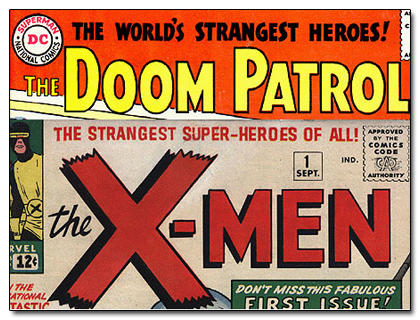
(Image from Cracked)
This looks like another of Stan Lee's famous rip-offs:


Three months is not long enough to read a comic on the news stands and then create your own comic, so this argues for inside information. At the time, some DC artists were secretly moonlighting for Marvel: Gene Colan called himself Adam Austin, Gil Kane called himself Scott Edward, Jerry Siegel called himself "Joe Carter", etc. So Stan Lee, as editor, was in regular contact with insiders at DC. Arnold Drake, creator of Doom patrol, explained:
' ...I've become more and more
convinced that [Stan Lee] knowingly stole The X-Men from The Doom
Patrol. Over the years I learned that an awful lot of writers and
artists were working surreptitiously between [Marvel and DC]. Therefore
from when I first brought the idea into [DC editor] Murray Boltinoff's
office, it would've been easy for someone to walk over and hear that [I
was] working on a story about a bunch of reluctant superheroes who are
led by a man in a wheelchair. So over the years I began to feel that
Stan had more lead time than I realized. He may well have had four, five
or even six months. '
On a previous page we saw the evidence that Jack Kirby plotted the
Fantastic Four, and then Stan Lee wrote the dialog based on Kirby's
notes. On this page we saw that Kirby had the initial idea for the
Fantastic Four, and he probably created the other major Marvel
characters as well. Sometimes Lee
remembers it differently, but Stan's memory is not reliable. All the
facts point to Jack Kirby being the ideas man, and Stan Lee being the
promoter and public face of the business.
If that seems hard to believe, just look around you today. Today,
Marvel makes most of its money from movies. Stan Lee's face is on every
Marvel movie, because he is the company mascot. But he does not make the
creative decisions. Nothing has changed.